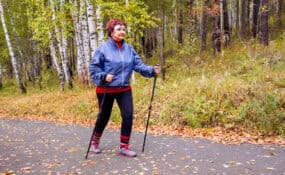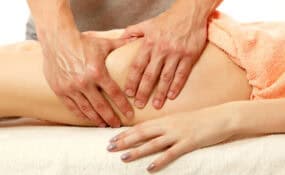
Today I’d like to share a cautionary tale about re-injury that we see very commonly in our physical therapy clinic. People who have been injured but are doing really well with treatment and recovering nicely will start to feel “pretty good.” They return to most of the activities that their pain was keeping the from. They get back on the trail running, playing with their kids around the house, or even go back on the golf course to play the game they love.
At this point, during a PT session, they will often say they “still feel it a little,” but it is not much of a problem. This is where trouble can begin…
Learning The Hard Way
We know from experience that sometimes “pretty good” is not good enough. But at this point, many decide that the pain is so minor, they don’t really need to continue treatment.
I’ll explain exactly why this can cause big problems and cost them a lot more money than if they’d just completed that last 1 or 2 treatments and attained 100% recovery.
May I tell you two short, and true stories. One is about a friend of mine and the second is about a silly mistake I made.
My friend tells his own story of making the mistake of not finishing his treatment.
“I was in Mexico doing some work with local indigenous villages helping them build a school. I ate some local cuisine that I was assured was not washed with their water.
As anyone who has spent time in Mexico knows, even eating eating produce washed with local water can create some serious health issues. I invariably got sick from the cuisine—which was amazing by the way.
This led me to come back to the main city to a hospital because I was getting quite dehydrated from the intestinal issue I was dealing with.
After meeting the doctor, I was given some antibiotics and told very clearly to finish out the prescription even if I was feeling better. Of course, being 20 years old, I took most of the antibiotics but stopped once I felt “good enough.”
What happened next was predictable and quite common. Once I stopped taking the antibiotics, I felt terrible again. This is a lesson I learned the hard way.”
When a physical therapy specialist prescribes a certain amount of treatment, the goal is to ensure every patient gets the right amount of “medicine” we provide.
If you see your treatment through its entire prescription, you give yourself the best chance of recovering fully and staying 100% better. “Good enough” is not good enough.
Here is my own story about learning to complete my full treatment or “medicine”.
Years ago, I was working towards testing for my first degree black belt in American Karate, while in my mid 40’s no less. As the needed skills and training got harder, I eventually had to acknowledge my 10 year old knee injury would not allow me to complete the jumping, spinning and twisting maneuvers required for my next color belt test. And not willing to abandon my goal of black belt, I scheduled a surgery for my right knee.
Being a therapist, and knowing what to expect after knee surgery really did help me, and overall I was a pretty good “patient” doing my exercises regularly and not overdoing it. By my third month, I was really back to all my regular activities, even back to participating in karate classes, and now without any of the “ice-pick” sharp pain even when I did lunging, twisting and jumping.
My swelling was all gone even with aggressive exercises.
I thought I was in the clear… and so I stopped my advanced therapy exercise.
I thought I was fine until I noticed this…
I started to notice I just didn’t have same spark while doing karate. I could do the tasks in the classes, but my jumping/spinning kicks were just not right. I didn’t have any pain, and I think that’s why it took me awhile to notice what was missing.
I had to ask myself. If I was the client, coming to see me, the PT, what would I do and/or say.
The answer came pretty quickly. Well lets check all the systems to get a full picture of what is going on to cause my problem with jumping.
I was able to quickly determine it was not a problem in the joint, knee caps, ligaments, tendons or even the scarring that normally occurs after surgery and frequently is the limiting factor for people’s difficulty return to full function after surgery.
The muscles also felt fully strong, including I was able to perform a full squat and even lunges without any pain.
Last I did a “power test” to measure the muscle ability to act quickly. We can do this in the clinic is a number of ways… and for the knee/hip, in the clinic we can test this simply by doing a measured jump test… on one leg. So I did this.
Standing on my left leg, I could forward broad jump 4 feet. Then I tried my post/op right knee. I jumped less that 1 foot!!
Initially I was shocked. I didn’t have any pain in my knee and walking was normal. But I just hadn’t finished my recovery training to allow my knee to functional normally, and I was setting myself up for failure if I did not address this.
Why did I miss this seeing that I was not done my “treatments”?
Frankly, I think I just forgot about pushing my knee to full recovery, probably for two reasons. One, I was not having any symptoms anymore, even with aggressive exercise routines. Secondly, I did not have the oversight of a “therapist” to improve my vision and to see what I was missing. I realized afresh this is why mirrors, close friends and/or a therapist are so helpful. To carefully and honestly help give us another view of ourselves from another perspective.
How Quitting When You Feel “Pretty Good” Leads To Re-Injury
Symptoms, abnormal movement patterns, and weaknesses need to be 100% resolved. Consequently, if you prematurely stop your therapy, it leaves the door open for re-injury or the return of stronger symptoms.
This is because abnormal movement compensations/strains will still be occurring to some degree, and those can build up over time just like they did before. Stopping at “80% better” because you feel “good enough” and you’re no longer limited in your activities can eventually put you back to square one. Unfortunately, this can cost you much more over time and knock you back out of your beloved sport/competition or ability to work.
It is important to see your treatment plan of care through its entirety for these 3 reasons:
- Pain is a sign that something is wrong even if it is minimal. When the pain is still there or it returns, it means something is still wrong and should be addressed quickly.
- When you see your treatment through till you are completely pain-free, you give yourself the best chance of avoiding re-injury. And that means your pain does not come back in the future.
- The body is much quicker to adapt than it is to heal. Adaptations can get in the way of us truly healing and staying 100% better.
So whether you’re getting treatment at our Hurst clinic or somewhere else, see your therapy through til you are 100% pain-free. Then you will be able to get back to doing all the things you love. You don’t have to “just live with” pain … even if it’s minor.
- 5 Holiday Eating Habits That Could Be Making Your Back Pain Worse - December 1, 2024
- Beyond Pain Relief: How Physical Therapy Improves Daily Function and Quality of Life - November 1, 2024
- Managing Chronic Pain Without Pills: Physical Therapy Solutions for Aging Adults - October 1, 2024














